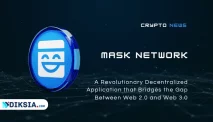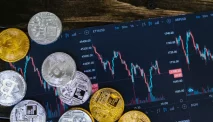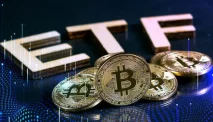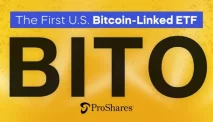Diksia.com - Imagine a blockchain platform that can process thousands of transactions per second with low fees and high security. A platform that can support various applications such as decentralized finance, gaming, non-fungible tokens, and more. A platform that can scale with the demands of the modern internet and the future of web3. Sounds too good to be true, right? Well, not anymore. Meet Solana, the world’s fastest smart contract platform.
In this article, we will explore what Solana is, how it works, why it is important, what makes it unique, what are its features, how it came about, what is its technology, what is its market, and what is its investment potential. By the end of this article, you will have a better understanding of Solana and its potential to revolutionize the blockchain industry. Let’s get started.
Introduction
Solana is a highly functional open source project that banks on blockchain technology’s permissionless nature to provide decentralized finance (DeFi) solutions. While the idea and initial work on the project began in 2017, Solana was officially launched in March 2020 by the Solana Foundation with headquarters in Geneva, Switzerland.
Solana Details
| Name | Solana |
|---|---|
| Symbol | SOL |
| Launch Date | March 2020 |
| Consensus Mechanism | Proof-of-History + Proof-of-Stake |
| Block Time | 400 milliseconds |
| Transactions per Second | 50,000+ |
| Average Transaction Fee | $0.00025 |
| Circulating Supply | 404,372,624 SOL |
| Total Supply | 553,689,123 SOL |
| Market Capitalization | $9,849,659,183 USD |
| All-Time High | $260.06 USD (Nov 06, 2021) |
| All-Time Low | $0.5052 USD (May 11, 2020) |
What is Solana?
Solana is a programmable blockchain that strives to perform high-speed transactions without losing its core feature, decentralization. The network uses a novel mechanism called the proof-of-history (PoH), which timestamps transactions before they are ordered and validated by the underlying proof-of-stake (PoS) consensus of the blockchain. This allows Solana to process thousands of transactions per second with low fees and high security.
Solana also supports smart contracts, which are self-executing agreements that run on the blockchain and enable various applications such as DeFi, gaming, NFTs, and more. Solana claims to be the fastest smart contract platform in the world, with over 400 projects built on its ecosystem.
Who Are the Founders of Solana?
Solana was founded by Anatoly Yakovenko and Raj Gokal in 2018. Yakovenko is a former software engineer at Qualcomm and Dropbox who came up with the idea of PoH after observing how GPS satellites use timestamps to synchronize data across a large network. Gokal is a former product manager and COO at various startups who oversees the business operations and strategy of Solana.
The Solana team also includes other experienced engineers and entrepreneurs from companies such as Google, Apple, Microsoft, Twitter, Intel, and more.
Why is Solana Important?
Solana is important because it aims to solve one of the biggest challenges facing blockchain technology: scalability. Scalability refers to the ability of a network to handle a large number of transactions without compromising speed, security, or decentralization. Many existing blockchains struggle with scalability issues, as they often face trade-offs between these three factors.
For example, Bitcoin can only process about 7 transactions per second with an average fee of $10 USD and a block time of 10 minutes. Ethereum can process about 15 transactions per second with an average fee of $20 USD and a block time of 13 seconds. These limitations make it difficult for these networks to support mass adoption and mainstream use cases.
Solana claims to overcome these limitations by using PoH and other innovations such as parallel processing, pipelining, compression, and more. By doing so, Solana hopes to enable a new wave of applications that can leverage the benefits of blockchain technology without sacrificing performance or user experience.
What Makes Solana Unique?
Solana is unique because it combines several features that make it stand out from other blockchain platforms. Some of these features are:
- Proof-of-History: A cryptographic clock that timestamps transactions before they are validated by the PoS consensus. This allows Solana to achieve high throughput and low latency without relying on a centralized authority or coordinator.
- Proof-of-Stake: A mechanism that secures the network by requiring validators to stake SOL tokens as collateral. Validators earn rewards for producing blocks and validating transactions, while losing their stake if they act maliciously or go offline.
- Sealevel: A parallel smart contract engine that enables multiple smart contracts to run simultaneously on different hardware threads without interfering with each other. This maximizes the utilization of the network’s computational resources and improves scalability.
- Turbine: A block propagation protocol that breaks down large blocks into smaller packets and distributes them across the network in a peer-to-peer fashion. This reduces bandwidth requirements and latency for validators and nodes.
- Gulf Stream: A mempool-less transaction forwarding protocol that allows validators to cache and stream transactions to the edge of the network, where they are executed before the next block is produced. This eliminates the need for mempools, which are often a source of congestion and high fees on other networks.
- Cloudbreak: A horizontally scalable data structure that organizes accounts and contracts into columns and rows, allowing for fast and concurrent reads and writes. This enhances the performance and capacity of the state storage.
- Archivers: A network of nodes that store historical data of the blockchain and provide proofs of its validity. This enables Solana to offload data from validators and nodes, reducing their storage and memory requirements.
What are the key features of Solana?
Some of the key features of Solana are:
- Fast: Solana can process over 50,000 transactions per second with a block time of 400 milliseconds, making it one of the fastest blockchain platforms in the world.
- Cheap: Solana has an average transaction fee of $0.00025 USD, which is significantly lower than most other networks. This makes Solana accessible and affordable for users and developers alike.
- Secure: Solana uses a combination of PoH and PoS to secure its network, ensuring that transactions are immutable and resistant to censorship or tampering. Solana also employs various cryptographic techniques and encryption standards to protect user data and privacy.
- Scalable: Solana is designed to scale with Moore’s Law, which states that the number of transistors on a chip doubles every two years. This means that as hardware gets faster, so will Solana. Solana also supports interoperability with other blockchains through bridges and protocols such as Wormhole, which allows for cross-chain transfers of tokens and data.
- Flexible: Solana supports various programming languages and frameworks for smart contract development, such as Rust, C, C++, TypeScript, Solidity, and more. Solana also offers a rich set of tools and libraries for developers to easily build and deploy applications on its platform.
Solana History
How did Solana come about?
Solana came about as a result of Yakovenko’s vision to create a blockchain platform that can scale to meet the demands of the modern internet. He was inspired by his experience working at Qualcomm, where he learned how to optimize wireless networks using radio technology. He applied this knowledge to blockchain technology and developed the concept of PoH as a way to synchronize a distributed system without relying on a central clock.
Yakovenko then teamed up with Gokal and other engineers to form Solana Labs, a company dedicated to building the Solana protocol and ecosystem. They raised seed funding from various investors, including Multicoin Capital, Foundation Capital, Slow Ventures, and more. They also launched a testnet in 2018 and invited developers and validators to join and test the network.
In 2019, Solana Labs conducted a private token sale, raising $20 million USD from investors such as Blocktower Capital, NGC Ventures, Passport Capital, and more. They also launched a public testnet and achieved over 50,000 transactions per second with over 200 nodes.
In 2020, Solana Labs conducted a public token sale on CoinList, raising $1.76 million USD from over 4,000 participants. They also launched the mainnet beta version of Solana in March 2020, marking the official launch of the network. They also partnered with various projects and platforms to integrate with Solana, such as Chainlink, Circle, Serum, Terra, Audius, FTX, and more.
In 2021, Solana Labs raised another $314 million USD in a private token sale led by Andreessen Horowitz and Polychain Capital. They also launched various initiatives and programs to support the growth and development of the Solana ecosystem, such as the Solana Season Hackathon, the Ignition Hackathon, the Breakpoint Conference, the Solana Foundation Grants Program, and more.
What is the development roadmap for Solana?
Solana has an ambitious development roadmap that aims to improve its network performance, security, usability, and adoption. Some of the main goals and milestones on its roadmap are:
- Launching Wormhole 2.0, which will enable trustless and decentralized cross-chain transfers of tokens and data between Solana and other blockchains such as Ethereum, Binance Smart Chain, Terra, Polygon, and more.
- Launching Optimistic Rollups (ORUs), which will allow developers to run scalable smart contracts on Solana using Ethereum-compatible tools and languages such as Solidity.
- Launching Starlight Network (SLN), which will provide a layer-2 scaling solution for Solana using state channels. This will enable instant and low-cost transactions for high-frequency use cases such as gaming, micropayments, streaming, etc.
- Launching Validator Identity Program (VIP), which will allow validators to register their identities on the blockchain using verifiable credentials.
- Launching Solana Program Library (SPL), which will provide a standard set of smart contracts and libraries for common functionalities such as token standards, governance, lending, borrowing, staking, etc.
- Launching Solana Name Service (SNS), which will allow users to register human-readable names for their accounts and contracts on the blockchain.
- Launching Solana Improvement Proposals (SIPs), which will allow the community to propose and vote on changes and upgrades to the Solana protocol and ecosystem.
Who are the key people behind Solana?
Some of the key people behind Solana are:
- Anatoly Yakovenko: The co-founder and CEO of Solana Labs. He is responsible for the vision and direction of the project. He is also the creator of PoH and the main architect of the Solana protocol.
- Raj Gokal: The co-founder and COO of Solana Labs. He is responsible for the business operations and strategy of the project. He is also involved in community building, partnerships, and fundraising.
- Eric Williams: The co-founder and CTO of Solana Labs. He is responsible for the technical development and innovation of the project. He is also an expert in distributed systems, cryptography, and network engineering.
- Greg Fitzgerald: The co-founder and CIO of Solana Labs. He is responsible for the research and education of the project. He is also a leading developer and contributor to the Solana codebase.
- Stephen Akridge: The co-founder and VP of Engineering of Solana Labs. He is responsible for the engineering team and the quality of the code. He is also a skilled programmer and problem solver.
Solana Technology
What is the underlying technology of Solana?
The underlying technology of Solana is a combination of PoH, PoS, and other innovations that enable it to achieve high performance, security, and scalability. Some of these technologies are:
- Proof-of-History: A cryptographic clock that timestamps transactions before they are validated by the PoS consensus. This allows Solana to achieve high throughput and low latency without relying on a centralized authority or coordinator.
- Proof-of-Stake: A mechanism that secures the network by requiring validators to stake SOL tokens as collateral. Validators earn rewards for producing blocks and validating transactions, while losing their stake if they act maliciously or go offline.
- Sealevel: A parallel smart contract engine that enables multiple smart contracts to run simultaneously on different hardware threads without interfering with each other. This maximizes the utilization of the network’s computational resources and improves scalability.
- Turbine: A block propagation protocol that breaks down large blocks into smaller packets and distributes them across the network in a peer-to-peer fashion. This reduces bandwidth requirements and latency for validators and nodes.
- Gulf Stream: A mempool-less transaction forwarding protocol that allows validators to cache and stream transactions to the edge of the network, where they are executed before the next block is produced. This eliminates the need for mempools, which are often a source of congestion and high fees on other networks.
- Cloudbreak: A horizontally scalable data structure that organizes accounts and contracts into columns and rows, allowing for fast and concurrent reads and writes. This enhances the performance and capacity of the state storage.
- Archivers: A network of nodes that store historical data of the blockchain and provide proofs of its validity. This enables Solana to offload data from validators and nodes, reducing their storage and memory requirements.
How does Solana work?
Solana works by using PoH as a source of truth and PoS as a source of security for its network. PoH acts as a cryptographic clock that timestamps transactions before they are ordered and validated by PoS. PoH also enables parallel processing, pipelining, compression, and other techniques that improve the efficiency and speed of the network.
PoS acts as a mechanism that secures the network by requiring validators to stake SOL tokens as collateral. Validators earn rewards for producing blocks and validating transactions, while losing their stake if they act maliciously or go offline. PoS also enables governance, delegation, slashing, and other features that enhance the reliability and stability of the network.
Solana also supports smart contracts, which are self-executing agreements that run on the blockchain and enable various applications such as DeFi, gaming, NFTs, and more. Solana claims to be the fastest smart contract platform in the world, with over 400 projects built on its ecosystem.
What are the advantages of Solana’s technology?
Some of the advantages of Solana’s technology are:
- Fast: Solana can process over 50,000 transactions per second with a block time of 400 milliseconds, making it one of the fastest blockchain platforms in the world.
- Cheap: Solana has an average transaction fee of $0.00025 USD, which is significantly lower than most other networks. This makes Solana accessible and affordable for users and developers alike.
- Secure: Solana uses a combination of PoH and PoS to secure its network, ensuring that transactions are immutable and resistant to censorship or tampering. Solana also employs various cryptographic techniques and encryption standards to protect user data and privacy.
- Scalable: Solana is designed to scale with Moore’s Law, which states that the number of transistors on a chip doubles every two years. This means that as hardware gets faster, so will Solana. Solana also supports interoperability with other blockchains through bridges and protocols such as Wormhole, which allows for cross-chain transfers of tokens and data.
- Flexible: Solana supports various programming languages and frameworks for smart contract development, such as Rust, C, C++, TypeScript, Solidity, and more. Solana also offers a rich set of tools and libraries for developers to easily build and deploy applications on its platform.
Solana Market
What is the current market capitalization of Solana?
The current market capitalization of Solana is $9,849,659,183 USD, as of December 17, 2021. This makes Solana the ninth-largest cryptocurrency by market cap, according to CoinMarketCap.
What is the trading volume of Solana?
The trading volume of Solana is $426,188,583 USD in the last 24 hours, as of December 17, 2021. This makes Solana the tenth-most traded cryptocurrency by volume, according to CoinMarketCap.
What are the top exchanges that list Solana?
Some of the top exchanges that list Solana are:
- Binance: The world’s largest cryptocurrency exchange by trading volume and liquidity. Binance offers spot, margin, futures, and options trading for Solana, as well as a savings and staking program.
- OKX: A leading global cryptocurrency exchange that offers spot, margin, futures, perpetual swap, and options trading for Solana, as well as a lending and staking program.
- WEEX: A fast and secure cryptocurrency exchange that offers spot and margin trading for Solana, as well as a savings and staking program.
- Deepcoin: A professional cryptocurrency exchange that offers spot, margin, futures, and options trading for Solana, as well as a lending and staking program.
- Bybit: A popular cryptocurrency derivatives exchange that offers futures and perpetual swap trading for Solana, as well as a cloud mining and staking program.
Solana Investment
Is Solana a good investment?
Solana is a good investment for investors who are looking for a fast-growing and innovative blockchain platform that can support various applications and use cases. Solana has shown impressive growth since its launch in 2020, reaching an all-time high of $260.06 USD in November 2021. Solana has also attracted a lot of attention from developers, users, partners, and investors who are interested in its technology and potential.
However, like any other cryptocurrency investment, Solana also comes with risks and challenges. Some of these are:
- Competition: Solana faces competition from other blockchain platforms that also aim to provide high-speed transactions and smart contract functionality, such as Ethereum 2.0, Cardano, Polkadot, Avalanche, Cosmos, etc. These platforms may have different features, advantages, or disadvantages compared to Solana, and may attract more users or developers in the future.
- Regulation: Solana operates in a highly uncertain and dynamic regulatory environment that may affect its development and adoption. Different countries or regions may have different laws or policies regarding cryptocurrencies or blockchain technology that may impact Solana’s operations or accessibility. For example, some countries may ban or restrict the use or trade of cryptocurrencies or impose taxes or fees on them.
- Security: Solana relies on PoH and PoS to secure its network, but these mechanisms are not immune to attacks or failures. For example, PoH may be vulnerable to clock manipulation or network delays that may affect the accuracy or consistency of timestamps. PoS may be vulnerable to stake grinding or long-range attacks that may compromise the integrity or finality of blocks. Moreover, Solana may also face other security risks such as bugs, hacks, or exploits that may affect its code, smart contracts, or wallets.
- Volatility: Solana is subject to high price volatility and market fluctuations that may affect its value and profitability. Solana’s price may be influenced by various factors such as supply and demand, news and events, sentiment and speculation, etc. Solana’s price may also be correlated or affected by the price movements of other cryptocurrencies, especially Bitcoin and Ethereum.
What are the risks of investing in Solana?
Some of the risks of investing in Solana are:
- Loss of funds: Investing in Solana involves the risk of losing some or all of the invested funds due to various reasons such as price drops, security breaches, technical issues, human errors, etc. Investors should only invest what they can afford to lose and be prepared for the possibility of losing their investment.
- Lack of liquidity: Investing in Solana may involve the risk of facing liquidity issues or difficulties in buying or selling the tokens due to various reasons such as low trading volume, limited availability, network congestion, exchange outages, etc. Investors should be aware of the liquidity conditions and fees of the exchanges or platforms they use to trade Solana.
- Lack of regulation: Investing in Solana may involve the risk of facing regulatory uncertainty or challenges due to the lack of clear or consistent rules or guidelines regarding cryptocurrencies or blockchain technology in different jurisdictions. Investors should be aware of the legal status and implications of investing in Solana in their respective countries or regions and comply with the relevant laws and regulations.
- Lack of protection: Investing in Solana may involve the risk of facing a lack of protection or recourse in case of disputes, frauds, scams, or other issues that may arise from using or trading Solana. Investors should be careful and diligent in choosing the platforms, services, or parties they deal with when investing in Solana and avoid falling for scams or phishing attempts.
How can I buy Solana?
There are different ways to buy Solana depending on the preferences and needs of the investors. Some of these ways are:
- Buying Solana with fiat currency: This is the simplest and most convenient way to buy Solana for investors who have access to fiat currency such as USD, EUR, GBP, etc. Investors can use various platforms such as exchanges, brokers, or wallets that support fiat-to-crypto transactions and offer Solana as an option. For example, investors can use platforms such as Binance, Coinbase, Kraken, Gemini, etc. to buy Solana with fiat currency using various payment methods such as bank transfers, credit cards, debit cards, etc.
- Buying Solana with cryptocurrency: This is another common way to buy Solana for investors who already have some cryptocurrency such as Bitcoin, Ethereum, etc. Investors can use various platforms such as exchanges, brokers, or wallets that support crypto-to-crypto transactions and offer Solana as an option. For example, investors can use platforms such as Binance, OKX, WEEX, Deepcoin, Bybit, etc. to buy Solana with cryptocurrency using various trading pairs such as SOL/BTC, SOL/ETH, SOL/USDT, etc.
- Buying Solana with other methods: There are also other methods to buy Solana that may suit different investors depending on their preferences and needs. For example, investors can use peer-to-peer platforms such as LocalCryptos or Paxful to buy Solana directly from other users using various payment methods such as cash, PayPal, gift cards, etc. Investors can also use decentralized platforms such as Uniswap or Serum to buy Solana using smart contracts and liquidity pools without intermediaries.
Conclusion
Solana is a blockchain platform that aims to provide high-speed transactions and smart contract functionality without sacrificing decentralization. Solana uses a novel mechanism called PoH combined with PoS to achieve high performance, security, and scalability. Solana also supports various applications such as DeFi, gaming, NFTs, and more.
Solana has shown impressive growth since its launch in 2020 and has attracted a lot of attention from developers, users, partners, and investors who are interested in its technology and potential. Solana has also achieved several milestones and goals on its development roadmap and has launched various initiatives and programs to support the growth and development of its ecosystem.
Solana is a good investment for investors who are looking for a fast-growing and innovative blockchain platform that can support various applications and use cases. However, investing in Solana also involves risks and challenges that investors should be aware of and prepared for. Investors should do their own research and due diligence before investing in Solana and only invest what they can afford to lose.
If you are interested in learning more about Solana or buying some SOL tokens, you can visit the official website of Solana or check out some of the platforms and services that offer Solana as an option. You can also join the Solana community on various social media platforms such as Twitter, Telegram, Discord, Reddit, etc. to stay updated on the latest news and developments of Solana.






